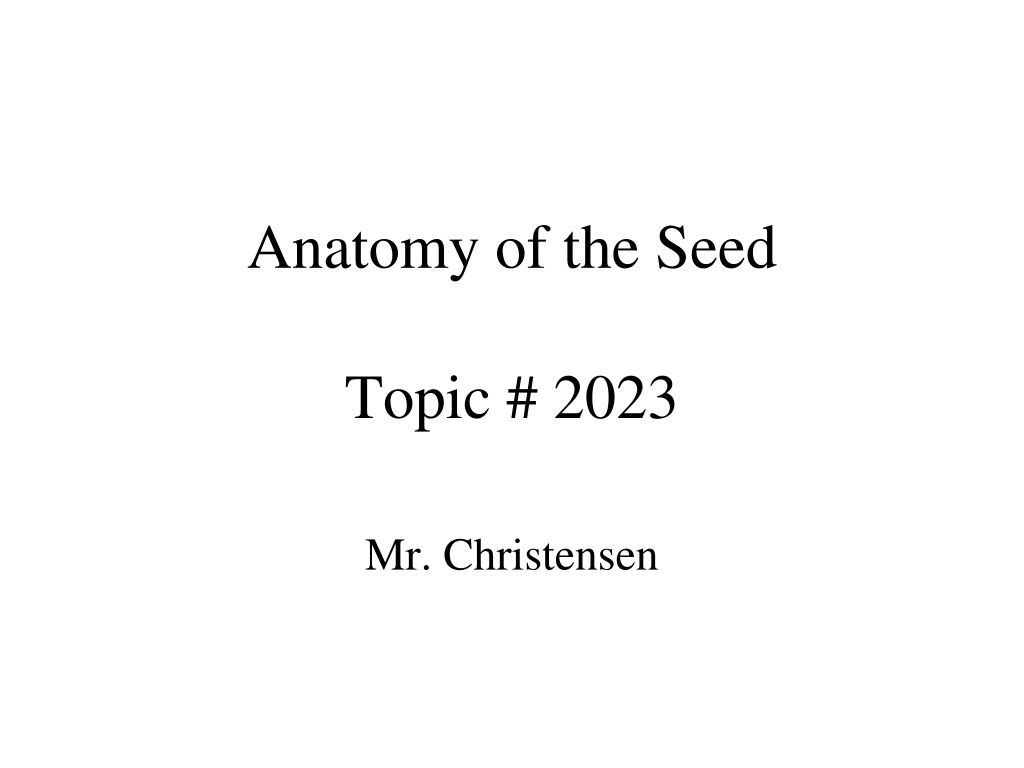Understanding Seed Anatomy and Germination Processes
Explore the anatomy of seeds, including taxonomic classes like angiosperms and gymnosperms, subclasses within angiosperms, and components of a seed such as the embryo, endosperm, and seed coat. Learn about seed germination conditions, dormancy, and factors like favorable temperature and scarification. Discover the crucial stages in a seed's life cycle and how different species have specific requirements for successful germination.
Download Presentation

Please find below an Image/Link to download the presentation.
The content on the website is provided AS IS for your information and personal use only. It may not be sold, licensed, or shared on other websites without obtaining consent from the author. Download presentation by click this link. If you encounter any issues during the download, it is possible that the publisher has removed the file from their server.
E N D
Presentation Transcript
Anatomy of the Seed Topic # 2023 Mr. Christensen
Taxonomic Classes Angiosperm The flowering plants, seeds are borne in an enclosed ovary (Examples Corn, beans and Maples 250,000 species). Gymnosperm The seeds of gymnosperms are borne naked with no ovary (Examples: Pines, spruces, and ginkgo 700 species) Minnesota Tree Care Advisors www.mntca.org/Reference_manual/tca_silver_maple.htm http://backyardnature.net/gymnos.htm
Subclasses of Angiosperms Monocot Plants that have one cotyledon (seed leaf) in their seeds (60,000 species). Dicot Plants that have two cotyledons in their seeds (185,000 species).
Seed Components A seed contains all of the genetic information needed to develop into an entire plant. It contains three parts. (1) Embryo-a miniature plant which will grow when conditions are favorable. (2) Endosperm-built in food supply for the plant. (3) Seed Coat Hard outer covering, protects the seed from disease and insects. Prevents water from entering the seed before the proper time.
Seed Germination Germination-Seed embryo goes from a dormant state to an active, growing state. Conditions for germination 1. The seed absorbs water through the seed coat 2. The seed has oxygen 3. The seed has a favorable temperature 4. Some species, require light (Celery) others darkness. 5. Dormancy Period
Favorable Temperature Most species require 65-860F. Some species have specific temperature requirements Cool temps (40-77) 0F (broccoli, carrot, celery, lettuce, onion, coleus, delphinium) Warm temps -above 50 0F; asparagus, corn, tomato -above 60 0F; beans, pepper, cucurbits
Seed Dormancy Seed coat dormancy-a hard seed coat does not allow water to penetrate (Redbud, locust). Scarification-breaking of the seed coat (fire, insects, digestion, fungi, mechanically or with chemicals. Embryo dormancy-seeds must go through a chilling period before germinating (elm, witch hazel) Stratification is used storing seeds in moist medium at temperatures between 320 and 500F.
Monocot Seed Parts http://www.pssc.ttu.edu/pss1321/web%20Topics/cpa2.htm
Hypogeal Emergence Iowa State University http//maize.agron.iastate.edu/images/corn/fig1.gif
Iowa State University http//maize.agron.iastate.edu/images/corn/fig1.gif
Dicot Seed Parts http://www.pssc.ttu.edu/pss1321/web%20Topics/cpa2.htm
Epigeal Emergence Iowa State University http//www.extension.iastate.edu/pages/hancock/agriculture/soybean/bean_develop/emergence.html
Epigeal Emergence HypogealEmergence Mrs. Killough s AP Biology Class www.flashnet/~ben8403/seedanat.html























